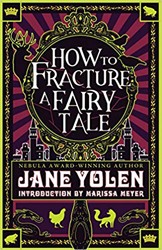Stephanie Feldman is a graduate of Barnard College. Her debut novel, The Angel of Losses, will be published by Ecco on July 29th. She will be blogging here all week for Jewish Book Council and MyJewishLearning.
 I grew up assuming that the Wandering Jew was a Jewish creation, our metaphor for the Diaspora. When I began studying gothic literature in college, however, I learned that he’s actually a Christian legend, a Roman who taunted Jesus and is punished with immortality.
I grew up assuming that the Wandering Jew was a Jewish creation, our metaphor for the Diaspora. When I began studying gothic literature in college, however, I learned that he’s actually a Christian legend, a Roman who taunted Jesus and is punished with immortality.
But I loved the Wandering Jew — his mystery, his magic, his mix of danger and tragedy. I couldn’t leave him behind to the more-or-less explicit anti-Semitism of 300-year-old British authors. I didn’t want him to be, as my professors would say, “the Other.”
I decided to write my own gothic novel with a Wandering Jew based on Jewish tradition. I studied Jewish folklore and history and found a wealth of wizards and travelers, some of whom appear in my novel, The Angel of Losses.
Here are a few of my favorite Wandering Jews:
1. Elijah
A body of Jewish folklore features the prophet Elijah, back on earth after his ascension to help pious Jews in need. He arrives as an unnamed stranger, and disappears again before anyone can guess his true identity.
2. Rabbi Akiba ben Joseph
The second-century rabbi is a famous mystic and religious scholar — “Head of all the Sages,” according to the Talmud — but he was also a political figure. Akiba traveled through the Middle East encouraging Jewish communities to support the Jewish general Bar Kochba, who led a briefly successful revolt against the Romans. I prize him for his legendary journey to paradise. According to lore, Akiba brought three rabbis with him on this forbidden mission. Upon breaching paradise, one died, another went insane, and the third became an apostate. Akiba, somehow, survived unscathed.
3. Eldad Ha-Dani
In the ninth century, Eldad Ha-Dani traveled through North Africa, the Middle East, and Spain, announcing himself as a member of an independent Jewish kingdom in Africa founded by four of the ten Lost Tribes of Israel. His contemporaries accepted as truth his tales of an extraordinarily wealthy, hidden Jewish nation. Today, scholars consider him to be a fraud, but his mastery of an unusual version of Hebrew suggests that he may have indeed come from some kind of surviving isolated Jewish community in Africa.
4. Benjamin of Tudela
A twelfth-century Spanish Jew, Benjamin of Tudela traveled through Europe, North Africa, and Asia. His narrative, recognized as a precursor of Marco Polo’s, features both meticulous observations of Jewish communities and fantastic tales of Jewish magicians and enigmatic tribes.
5. and 6. Shlomo Molko and David Reubeni
Messianic fever gripped the Jewish population in the wake of the fifteenth-century Spanish expulsion. Molko, the son of conversos, rediscovered his Jewish heritage and traveled through Europe and the Middle East with self-proclaimed Messiah David Ruebeni. Molko and Reubeni’s journey speaks to the desperation and hope of their time, the sense that the reassembly of the diaspora — and the Ten Lost Tribes of legend — was imminent. Molko was burned at the stake in Italy, and his shawl is still on display in Prague.
7. Israel Cohen
Reading him when I did, I came to see Israel Cohen, who published several books about the Jewish communities of Europe, as an early twentieth-century successor to Benjamin of Tudela. I couldn’t shake one of his notes about the Vilna Jewish library, which one of my characters adds to his collection of legends of the Wandering Jew: “Beneath the Library there was a little room, on the door of which in bold letters appeared the sign of a Hebrew scribe. The door opened as I descended, and out came a hungry-looking man, with sunken, stubbly cheeks, and a dirty collar.”
8. The White Rebbe
A medieval Polish legend describes a “White Rebbe” who sends a calf into a cave. When the animal fails to return, the holy man determines he’s discovered a magical path to Jerusalem. The White Rebbe descends into the cave himself and is never seen again.
I borrowed the name “White Rebbe” for my own Wandering Jew, the hero — or anti-hero — of the mysterious fairy tales my protagonist Marjorie Burke discovers among her late grandfather’s belongings. My White Rebbe’s story combines the magic, history, daring, and spiritual longing of the Jewish travelers I discovered in my research, and like the Wandering Jews of gothic literature, he refuses to remain safely in the past.
Stephanie Feldman lives outside Philadelphia with her husband and daughter. Read more about her and her work here.
Related Content:
- Essays: Wandering Jews
- The World to Come by Dara Horn
- Reading List: Jewish Folktales


